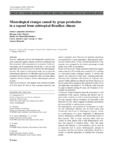Please use this identifier to cite or link to this item:
http://www.alice.cnptia.embrapa.br/alice/handle/doc/925182Full metadata record
| DC Field | Value | Language |
|---|---|---|
| dc.contributor.author | BORTOLUZZI, E. C. | pt_BR |
| dc.contributor.author | MOTERLE, D. F. | pt_BR |
| dc.contributor.author | RHEINHEIMER, D. dos S. | pt_BR |
| dc.contributor.author | CASALI, C. A. | pt_BR |
| dc.contributor.author | MELO, G. W. B. de | pt_BR |
| dc.contributor.author | BRUNETTO, G. | pt_BR |
| dc.date.accessioned | 2016-10-25T21:37:12Z | - |
| dc.date.available | 2016-10-25T21:37:12Z | - |
| dc.date.created | 2012-05-22 | pt_BR |
| dc.date.issued | 2012 | pt_BR |
| dc.identifier.citation | Journal of Soils Sediments, Berlin, v. 12, n. 6, p. 854-862, jun. 2012. | pt_BR |
| dc.identifier.uri | http://www.alice.cnptia.embrapa.br/alice/handle/doc/925182 | pt_BR |
| dc.description | Purpose Inadequate soil use and management practices promote commonly negative impacts on the soil constituents and their properties, with consequences to ecosystems. As the soil mineralogy can be permanently altered due to soil use, this approach can be used as a tool to monitor the anthropogenic pressure. The objective of the present study was to assess the mineralogical alterations of a Brazilian regosol used for grape production for 40 years in comparison with a soil under natural vegetation (forest), aiming to discuss anthropogenic pressure on soils. Material and methods Soil samples were collected at depths of 0?0.20 and 0.20?0.40 m from vineyard production and natural vegetation sites. Physical and chemical parameters were analysed by classic approaches. Mineralogical analyses were carried out on <2 mm, silt and clay fractions. Clay minerals were estimated by the relative percentage of peak surface area of the X-ray patterns. Results and discussion Grape production reduced the organic matter content by 28% and the clay content by 23% resulting in a decreasing cation exchange capacity. A similar clay fraction was observed in both soils, containing kaolinite, illite/mica and vermiculite with hydroxy-Al polymers interlayered. Neither gibbsite nor chlorite was found. However, in the soil under native vegetation, the proportion of illite (79 %) was higher than vermiculite (21 %). Whereas, in the soil used for grape production during 40 years, the formation of vermiculite was promoted. Conclusions Grape production alters the proportions of soil constituents of the regosol, reducing clay fraction and organic matter contents, as well as promoting changes in the soil clay minerals with the formation of vermiculite to the detriment of illite, which suggests weathering acceleration and susceptibility to anthropogenic pressure. Recommendations and perspectives Ecosystems in tropical and subtropical climates can be more easily and permanently altered due to anthropogenic pressure, mainly as a consequence of a great magnitude of phenomena such as temperature amplitude and rainfall that occurs in these regions. This is more worrying when soils are located on steep grades with a high anthropogenic pressure, like regosols in Southern Brazil. Thus, this study suggests that changes in soil mineralogy can be used as an important tool to assess anthropogenic pressure in ecosystems and that soil quality maintenance should be a priority in sensible landscapes to maintain the ecosystem quality. | pt_BR |
| dc.language.iso | eng | eng |
| dc.rights | openAccess | eng |
| dc.subject | Pressão antropogênica | pt_BR |
| dc.subject | Brasil | pt_BR |
| dc.subject | Alteração mineralógica | pt_BR |
| dc.title | Mineralogical changes caused by grape production in a regosol from subtropical Brazilian climate. | pt_BR |
| dc.type | Artigo de periódico | pt_BR |
| dc.date.updated | 2016-10-25T21:37:12Z | pt_BR |
| dc.subject.thesagro | Viticultura | pt_BR |
| dc.subject.thesagro | Uva | pt_BR |
| dc.subject.thesagro | Solo | pt_BR |
| dc.subject.thesagro | Mineral | pt_BR |
| dc.subject.thesagro | Potássio | pt_BR |
| dc.subject.thesagro | Manejo | pt_BR |
| dc.subject.thesagro | Tecnologia | pt_BR |
| dc.subject.thesagro | Regossolo | pt_BR |
| riaa.ainfo.id | 925182 | pt_BR |
| riaa.ainfo.lastupdate | 2016-10-25 | pt_BR |
| dc.contributor.institution | EDSON CAMPANHOLA BORTOLUZZI, UPF; DIOVANE FREIRE MOTERLE, IFRS/BG; DANILO DOS SANTOS RHEINHEIMER, UFSM; CARLOS ALBERTO CASALI, UFSM; GEORGE WELLINGTON BASTOS DE MELO, CNPUV; GUSTAVO BRUNETTO, UFSC. | pt_BR |
| Appears in Collections: | Artigo em periódico indexado (CNPUV)  | |
Files in This Item:
| File | Description | Size | Format | |
|---|---|---|---|---|
| BORTOLUZZIJSoilsSedimentsv12p8542012.pdf | 1,81 MB | Adobe PDF |  View/Open |









